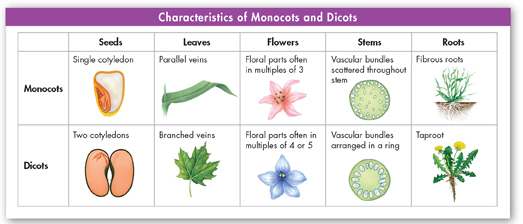Angiosperm Diversity
 How are different angiosperms conveniently categorized?
How are different angiosperms conveniently categorized?
While scientific classification best reflects the evolutionary relationships among flowering plants, many people who work with plants—for example, farmers, gardeners, and foresters—tend to categorize angiosperms using more convenient methods.  Angiosperms are often grouped according to the number of their seed leaves, the strength and composition of their stems, and the number of growing seasons they live. Naturally, these categories can overlap. An iris, for example, is a nonwoody plant, it has a single seed leaf, and it may live for many years.
Angiosperms are often grouped according to the number of their seed leaves, the strength and composition of their stems, and the number of growing seasons they live. Naturally, these categories can overlap. An iris, for example, is a nonwoody plant, it has a single seed leaf, and it may live for many years.
Monocots and Dicots As Figure 22–22 shows, angiosperms may be termed monocots or dicots based on the number of seed leaves, or cotyledons, they produce. Although we no longer classify both as scientific groups, the term is still useful. Monocots and dicots differ in characteristics such as the distribution of vascular tissue in stems, roots, and leaves, and the number of petals per flower. Monocots include plants such as corn, wheat, lilies, orchids, and palms. Monocot grasses—especially wheat, corn, and rice—have the important distinction of being the first plants to be cultivated in mass quantities for food. Dicots include roses, clover, tomatoes, oaks, and daisies.
MYSTERY CLUE

Fragments of cultivated wheat were found in Iceman's digestive tract. How did scientists confirm it was a monocot? How do you think they knew it was a cultivated form instead of wild?

FIGURE 22–22 Comparing Monocots and Dicots This table compares the characteristics of monocots and dicots. Interpret Tables How do the flowers of monocots and dicots typically differ?
dWoody and Herbaceous Plants The flowering plants can also be subdivided into groups according to the characteristics of their stems. One of the most important and noticeable stem characteristics is woodiness. Woody plants are made primarily of cells with thick cell walls that support the plant body. Woody plants include trees, shrubs, and vines. Shrubs are typically smaller than trees, and vines have stems that are long and flexible.
Plant stems that are smooth and nonwoody are characteristic of herbaceous plants (hur BAY shus). Herbaceous plants do not produce wood as they grow. Examples of herbaceous plants include dandelions, zinnias, petunias, and sunflowers.

Table of Contents
- Formulas and Equations
- Applying Formulas and Equations
- Mean, Median, and Mode
- Estimation
- Using Measurements in Calculations
- Effects of Measurement Errors
- Accuracy
- Precision
- Comparing Accuracy and Precision
- Significant Figures
- Calculating With Significant Figures
- Scientific Notation
- Calculating With Scientific Notation
- Dimensional Analysis
- Applying Dimensional Analysis




